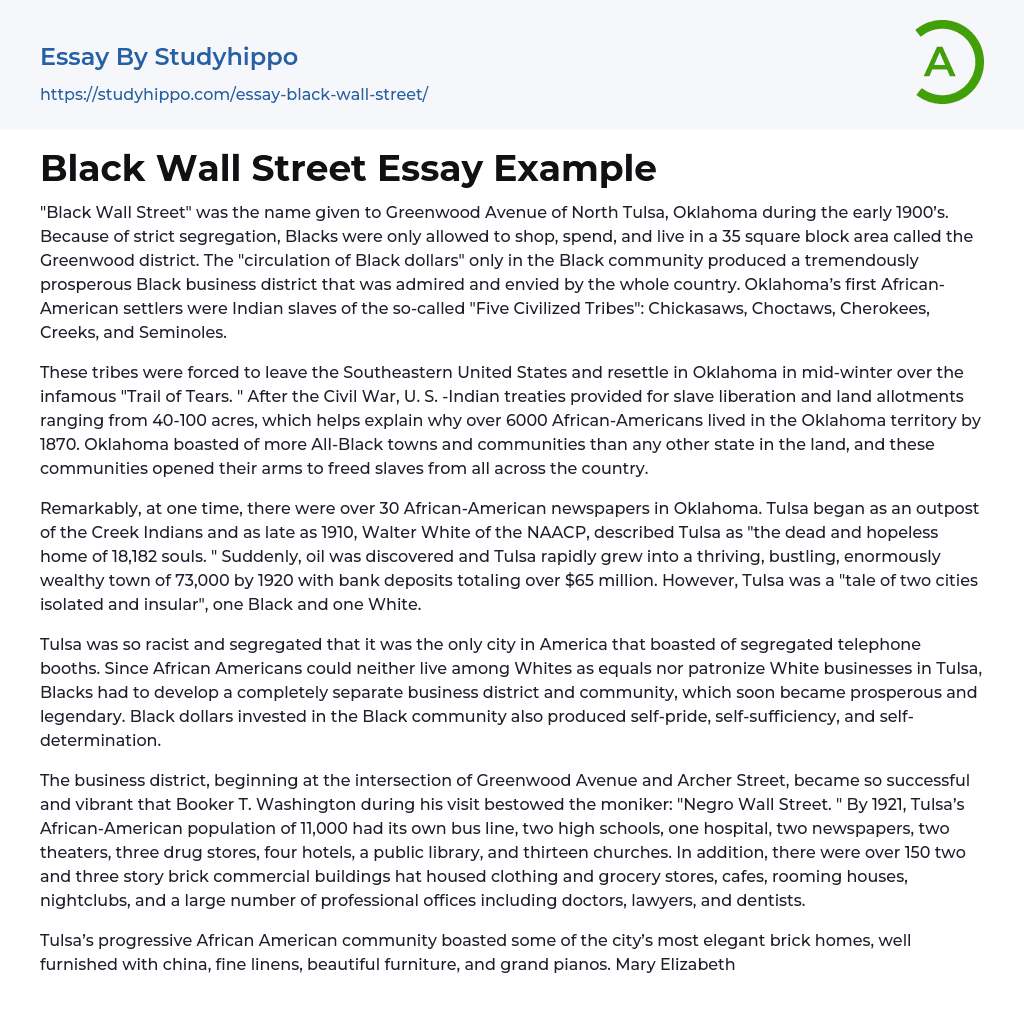These tribes were forced to leave the Southeastern United States and resettle in Oklahoma in mid-winter over the infamous "Trail of Tears. " After the Civil War, U. S. -Indian treaties provided for slave liberation and land allotments ranging from 40-100 acres, which helps expl
...ain why over 6000 African-Americans lived in the Oklahoma territory by 1870. Oklahoma boasted of more All-Black towns and communities than any other state in the land, and these communities opened their arms to freed slaves from all across the country.
Remarkably, at one time, there were over 30 African-American newspapers in Oklahoma. Tulsa began as an outpost of the Creek Indians and as late as 1910, Walter White of the NAACP, described Tulsa as "the dead and hopeless home of 18,182 souls. " Suddenly, oil was discovered and Tulsa rapidly grew into a thriving, bustling, enormously wealthy town of 73,000 by 1920 with bank deposits totaling over $65 million. However, Tulsa was a "tale of two cities isolated and insular", one Black and one White.
Tulsa was so racist and segregated that it was the only city in America that boasted of segregated telephone booths. Sinc
African Americans could neither live among Whites as equals nor patronize White businesses in Tulsa, Blacks had to develop a completely separate business district and community, which soon became prosperous and legendary. Black dollars invested in the Black community also produced self-pride, self-sufficiency, and self-determination.
The business district, beginning at the intersection of Greenwood Avenue and Archer Street, became so successful and vibrant that Booker T. Washington during his visit bestowed the moniker: "Negro Wall Street. " By 1921, Tulsa’s African-American population of 11,000 had its own bus line, two high schools, one hospital, two newspapers, two theaters, three drug stores, four hotels, a public library, and thirteen churches. In addition, there were over 150 two and three story brick commercial buildings hat housed clothing and grocery stores, cafes, rooming houses, nightclubs, and a large number of professional offices including doctors, lawyers, and dentists.
Tulsa’s progressive African American community boasted some of the city’s most elegant brick homes, well furnished with china, fine linens, beautiful furniture, and grand pianos. Mary Elizabeth Parrish from Rochester, New York wrote: "In the residential section there were homes of beauty and splendor which would please the most critical eye. Well known African American personalities often visited the Greenwood district including: educators Mary McCloud Bethune and W. E. B. DuBois, scientist George Washington Carver, opera singer Marian Anderson, blues singer Dinah Washington, and noted Chicago chemist Percy Julian. T. P. Scott wrote in "Negro City Directory": "Early African American business leaders in Tulsa patterned the development of Tulsa’s thriving Greenwood district after the successful African American entrepreneurial activity in Durham, North Carolina.
After the Civil War, former slaves moved to Durham from the
neighboring farmlands and found employment in tobacco processing plants. By 1900, a large Black middle class had developed which began businesses that soon grew into phenomenally successful corporations, especially North Carolina Mutual Life Insurance Company. Charles Clinton Spaulding was so successful with the North Carolina Mutual Life Insurance Company that he was able to create a real estate company, a textile and hosiery mill, and the "Durham Negro Observer" newspaper.
Durham Blacks also created a hospital, Mechanics and Farmers Bank (1908), North Carolina Training College (1910), Banker’s Fire Insurance Company (1920), and the National Negro Finance Company (1922). However, living conditions in Durham were so substandard and working conditions so poor that the 1920 mortality rate among Blacks in Durham was three times higher than the White rate. As of 1926, 64% of all African Americans in Durham died before the age of 40. These perilous working and living conditions were not present in Tulsa.
- John Locke essays
- 9/11 essays
- A Good Teacher essays
- A Healthy Diet essays
- A Modest Proposal essays
- A&P essays
- Academic Achievement essays
- Achievement essays
- Achieving goals essays
- Admission essays
- Advantages And Disadvantages Of Internet essays
- Alcoholic drinks essays
- Ammonia essays
- Analytical essays
- Ancient Olympic Games essays
- APA essays
- Arabian Peninsula essays
- Argument essays
- Argumentative essays
- Art essays
- Atlantic Ocean essays
- Auto-ethnography essays
- Autobiography essays
- Ballad essays
- Batman essays
- Binge Eating essays
- Black Power Movement essays
- Blogger essays
- Body Mass Index essays
- Book I Want a Wife essays
- Boycott essays
- Breastfeeding essays
- Bulimia Nervosa essays
- Business essays
- Business Process essays
- Canterbury essays
- Carbonate essays
- Catalina de Erauso essays
- Cause and Effect essays
- Cesar Chavez essays
- Character Analysis essays
- Chemical Compound essays
- Chemical Element essays
- Chemical Substance essays
- Cherokee essays
- Cherry essays
- Childhood Obesity essays
- Chlorine essays
- Classification essays
- Cognitive Science essays




